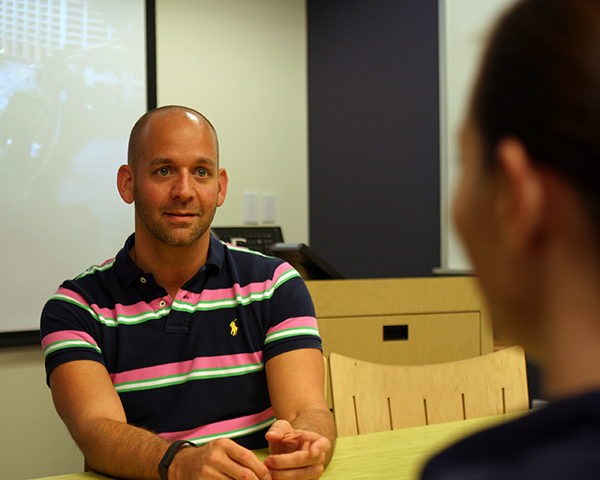Years ago, when Kim Braxton (Academic Technology Services) transferred to me the supervision of the Computing Center student staff, I welcomed the opportunity to grow professionally. I had no experience supervising or managing staff, but I did have a long history of assuming responsibility for people and processes that dates back to childhood.
As children, my cousins and I pretended we owned a store, and invariably, I was the store manager. I ensured all items were properly grouped, that ample room was allowed for our “customers” to mill around, that each cousin had a designated department and that all prices were fair. As a senior in high school, I was drum major of my high school marching band. I demonstrated complex marching formations, lead band members through rigorous marching drills and marched them on and off the field during half time of football games. As an adult captaining numerous flag football teams, I drafted players, assigned positions, orchestrated offenses and defenses and taught the game to eager new players with little to no playing experience.
Despite my experience, though, I quickly learned how ill-prepared I was to manage the spectrum of attitudes and behaviors represented by a staff of 20 undergraduate and graduate millennial students. With Kim’s guidance and my own experience, I learned a few valuable lessons that made me a successful leader of a diverse and dynamic team.
Leaders Must Provide Clear Expectations
Kylie once ate a bacon turkey wrap while helping a student import video for an iMovie project. Eileen often took her shoes off and walked barefoot through the facility while at work. Troy used work time to call friends and family to report the mundane events of the preceding days and weeks. Each of the incidents infuriated me, and I responded with obvious frustration and sometimes, outright anger. My reaction to their behaviors resulted in little change, tremendous resistance and on several occasions, tears. For many staffers, working in the Computing Center was their first paying job, and I was their first boss. They had not learned responsible, professional behaviors. With time, I realized that the conflict we all felt was a result of unclear, sometimes undefined expectations.
To address this short-coming, we created a Student Staff Guidelines and Expectations document. Among other things, it detailed providing quality customer service, acting in a professional manner and handling attendance issues as they arise. This document is now presented to staff during the mandatory training day every Fall semester and is revisited throughout their tenure. Staff often refer to it when needing policy clarification and have even suggested additions as procedures and services have evolved.
Leaders Must Provide Valuable Feedback
At the end of each semester, I met individually with staffers to discuss the events of the semester and to give them the opportunity to suggest any policy or procedure changes. Often, staff mentioned that they did not know if they were doing a good or bad job. Staff were getting little feedback and were unsure if the quality of their work (or lack thereof) was being recognized. I assumed staff understood that If I wasn’t complaining about their work, they must be doing a good job. Obviously, I was wrong. They needed to hear on-going what I thought of their work; not just at the end of the semester.
So, I started providing immediate feedback that was clear and directed. As I saw committed staffers working through complex issues with customers, I congratulated them on providing an appropriate solution. When staffers remained calm while dealing with an upset or irate customer, I thanked them for their patience and maturity. Conversely, I corrected staff when they showed up late for work, neglected to do their work in a timely manner or diverted their attention while I explained something they did not find particularly interesting. While I had to become more observant of staff behaviors in order to provide accurate and timely feedback, I saw work habits and attitudes gradually improve for many of the staff.
Leaders Must Contextualize Work
Over the years, I hired Computing Center staff more for their ability to provide high quality customer service than for technical skills. Most had minimal experience supporting technology, so methods of supporting technical issues were often forgotten as quickly as they were explained. For example, as part of everyday support work in the Computing Center, I often referred to the computer imaging process. I guided staff through the steps for imaging a laptop or desktop and expected them to remember it for next time. Of course, they did not retain the information and frustration once again set in.
But, by providing context to their work, staff members were able to provide better support for technology and better service to customers. As part of their individual new staff training, I started showing them how and why we created, captured and deployed images. Understanding how the final step (imaging a laptop) fit into the entire imaging process improved staff retention of information and their ability to image laptops and desktops with little guidance or supervision. I applied this lesson to many areas of support provided by my staff and watched as they were able to grasp concepts better and work with greater autonomy.
And now, as I transition from student staff supervisor to Manager of the Student Services team, I will apply the preceding lessons to the work that lays ahead. In my experience, defined, observed and contextualized work equals quality work and engaged, productive employees. And, while working with millennials presented opportunities for me to teach them valuable professional lessons, I am indebted to them for the many lessons they taught me about being a competent and successful leader.

